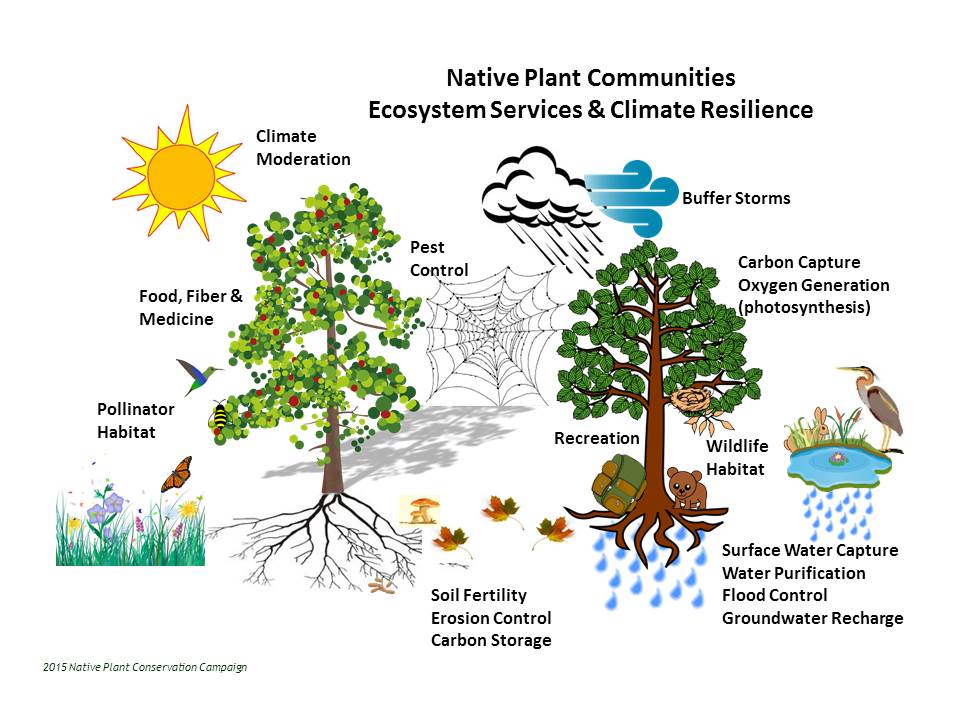Plant Conservation Year in Review
2015
2015 was an historic year for plant conservation in the United States – and for the Native Plant Conservation Campaign!
The Native Plant Conservation Campaign celebrated several milestones:
- We held our inaugural NPCC conference call bringing together native plant societies and botanic gardens from throughout the country. We discussed challenges and successes and began to set priorities to improve cooperation and collaboration within the plant conservation community.
- We welcomed new members to the NPCC advisory council: Nancy Morin of the California Native Plant Society and the Flora of North America, Leah Oliver of NatureServe, Ileene Anderson of the Center for Biological Diversity, and Jake Sigg of the California Native Plant Society.
- We revised and updated the NPCC webpage with a new look and new information, particularly regarding the ecosystem services supplied by native plant communities, the inadequacy of staffing and funding for plant science and conservation, and the Global Strategy for Plant Conservation.
- We launched an NPCC Facebook page. Please like us on Facebook!
- New organizations joined the Equal Protection for Plants Project, calling for modernizing the federal Endangered Species Act so that it provides the same protections to imperiled plants as it does for animals.
Preference for Local Native Plant Materials is Now Federal Policy!
Years of advocacy by botanists and conservation advocates has borne fruit. In 2015, historic new initiatives mandated new federal policy that locally appropriate native plants be used in a wide range of land management activities, including restoration, rehabilitation, and pollinator habitat management:
- The National Seed Strategy establishes a network of local native plant materials research, propagation and storage centers for wildland restoration and rehabilitation following wildfire, mismanagement, or other ecosystem damage
- The National Pollinator Strategy encourages the development and expansion of pollinator friendly gardens and landscapes, also using locally appropriate plant materials
The goal of these strategies is to manage, restore, and rehabilitate diverse, healthy and resilient plant communities that can withstand climate change and continue to supply the ecosystem services that are essential to life.
***This is the first time that any nation has adopted such a policy or implemented these types of strategies to use local native plants for ecosystem management!***
Botanical Sciences and Native Plant Materials Research, Restoration and Promotion Act of 2016
This bill, developed this year in collaboration with the Plant Conservation Alliance Non-federal Cooperators, would:
- Codify the preference for locally appropriate native plant materials in federal land management
- Increase training and hiring of botanists by federal agencies
- Increase funding for imperiled plant conservation
- Establish new programs for imperiled plant conservation
- The NPCC and other organizations are working to generate support for this legislation among native plant science and conservation organizations and identify elected officials to sponsor it.
Endangered Species Act Intact for Now -- thanks to YOU!
The NPCC renewed our longstanding collaboration with the Endangered Species Coalition to help build a unified campaign to defend the federal Endangered Species Act against unprecedented attacks in Congress.
- With the help of native plant societies, we defeated the attacks on ESA!
- Native plant conservation groups joined a letter to President Obama asking him to oppose legislation that would weaken the ESA
- Native plant societies are working with regional ESA defense coalitions, led by the Endangered Species Coalition
- This work will continue, as we expect the Congressional attacks on the ESA to resume in 2016.
 Ecosystem Services Value Must Now be Evaluated in Federal Plans!
Ecosystem Services Value Must Now be Evaluated in Federal Plans!In October, after years of effort by the scientific and conservation communities, the White House released a
memorandum directing all Federal agencies to incorporate the value of natural infrastructure (aka natural capital or native plant communities) and ecosystem services into Federal planning and decision making. Agencies will develop policies that promote consideration of ecosystem services in planning, investment, and regulatory actions.
Ecosystem services include water purification, storm protection, pollinator habitat, soil fertility, flood control, pest control, and climate change mitigation. For more information, see
NPCC News and the
NPCC Ecosystem Services page.
Thank you for all your hard work, and we look forward to working with you to build on this in 2016.


 Ecosystem Services Value Must Now be Evaluated in Federal Plans!
Ecosystem Services Value Must Now be Evaluated in Federal Plans!